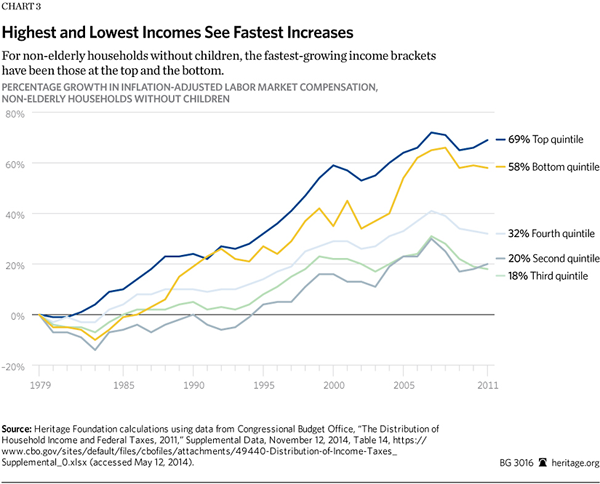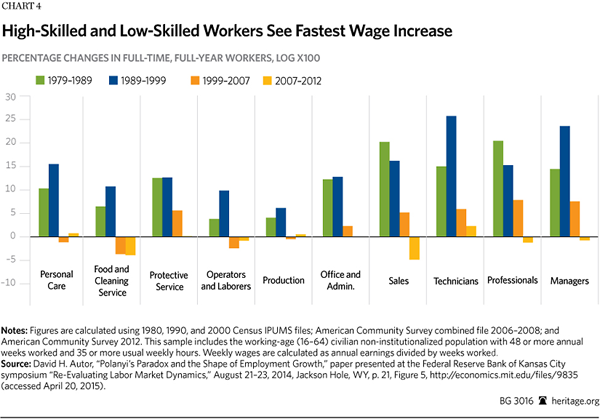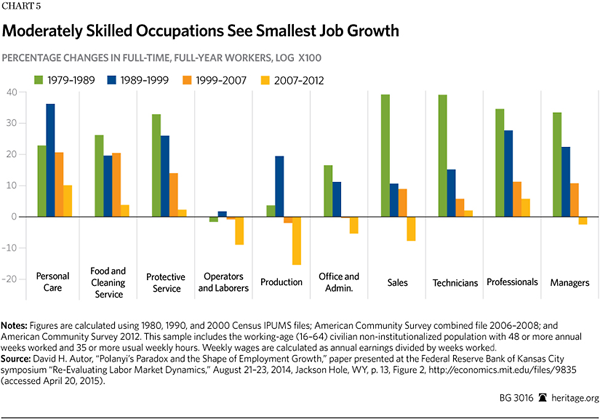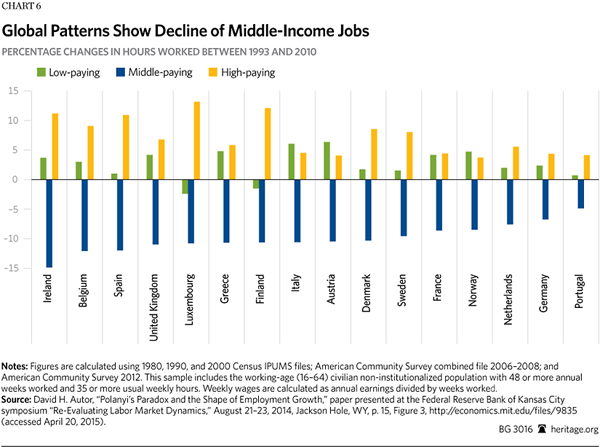Many Americans worry that automation will significantly reduce the need for human employees. Historical experience should help to alleviate many of these concerns. Technological advances have eliminated specific jobs and reduced prices, but the historical record shows this has left consumers with more money to spend elsewhere, increasing the demand for human labor in other sectors of the economy. Some prominent economists suggest that this time is different. They fear that advances in computer technology will substantially reduce the demand for human labor, especially less-skilled labor.
The data suggest that these concerns are similarly misplaced. Productivity growth has slowed over the past decade. The less-skilled employees who are often seen as endangered by automation have seen their employment and compensation grow at above-average rates. Automation is changing the type of work Americans do, but not the overall need for human labor. Technological progress continues to enable Americans to attain higher living standards.
Long-Standing Concerns
Many analysts fear that technological advances will soon make much human labor redundant.[1] They predict that many employers will soon lack productive tasks for less-skilled Americans. Historically, these concerns surface most often when cyclical unemployment is high. During the Great Depression, British economist John Maynard Keynes predicted impending mass “technological unemployment”:
In quite a few years—in our own lifetimes I mean—we may be able to perform all the operations of agriculture, mining, and manufacture with a quarter of the human effort to which we have been accustomed.…
…We are being afflicted with a new disease of which some readers may not yet have heard the name, but of which they will hear a great deal in the years to come—namely, technological unemployment. This means unemployment due to our discovery of means of economising the use of labour outrunning the pace at which we can find new uses for labour.[2]
After World War II, the American and British economies recovered and those fears subsided. They resurfaced in America again after the 1957 and 1960 recessions. In 1961, Time magazine reported:
How much has the rapid spread of technological change contributed to the current high of 5,400,000 out of work? Labor Secretary Arthur Goldberg last week set up a special group to find an answer. While no one has yet sorted out the jobs lost because of the overall drop in business from those lost through automation and other technological changes, many a labor expert tends to put much of the blame on automation.…
In the past, new industries hired far more people than those they put out of business. But this is not true of many of today’s new industries.... Today’s new industries have comparatively few jobs for the unskilled or semiskilled, just the class of workers whose jobs are being eliminated by automation.[3]
Shortly afterward, the economy began a prolonged expansion that raised incomes and created millions of new jobs. By 1968, the unemployment rate fell to 3.4 percent.
Lump of Labor Fallacy
Fears of mass technological unemployment are predicated on a “lump of labor” model of the economy—the belief the economy needs a roughly fixed amount of work performed.[4] In this economic model, machines automating work formerly done by people reduce the total amount of work remaining for humans, reducing total employment. Keynes forecast an impending crisis of unwanted leisure. He suggested future societies would establish three-hour workdays to give everyone enough work to avoid boredom.[5]
Almost all economists reject this model today. Economists have found that an almost unlimited amount of potential work exists in the economy because people’s material desires continue to expand. Virtually all Americans today enjoy material living standards vastly better than the wealthy of 1900. Nonetheless, most Americans today would purchase additional goods and services if they received a raise or bonus.
Automation does reduce the human labor needed to produce particular goods and services, but it also reduces production costs. Competition forces firms to pass these savings on to their customers through lower prices. These lower prices lead consumers to buy more of the now less-expensive product and leave them with more money to spend elsewhere, increasing the demand for labor in those sectors of the economy. The amount of work in the economy expands to use the available labor supply.
Economists strongly agree on this point. The University of Chicago recently asked a panel of prominent economists whether they agree that “advancing automation has not historically reduced employment in the United States.” Over three-fourths expressly agreed with that statement, and only one of the economists disagreed.[6]
America’s economic history illustrates how technology reallocates—but does not eliminate—human labor. In 1910, approximately one-third of all Americans worked on farms,[7] food was expensive, and the typical family spent almost half its budget on food. By 1960, technological advances such as the tractor had reduced the proportion of Americans working on farms to well under one-tenth.[8] This transition did not lead to mass unemployment. Instead, former farmhands began working in offices and factories. They enjoyed less expensive food and newly available manufactured goods.[9]
Since then the manufacturing sector has also found new ways to automate tasks. Between 1960 and 2014, the proportion of Americans working in factories fell by two-thirds even as output dramatically increased.[10] Former manufacturing workers moved into the service sector. They enjoyed even more affordable food, less expensive manufactured goods, and newly available services. As of 2003 the average family spent just one-eighth of its budget on food.[11]
Greater Living Standards
Technological progress enables employees to produce vastly more goods and services with their labor. This increases their compensation because competitive labor markets compel employers to pay employees proportionately to their productivity. Technological advances would only reduce aggregate employment if Americans stopped spending their increased earnings on new goods and services—something that has yet to happen.
Chart 1 illustrates this, showing average U.S. hourly labor productivity between 1973 and 2014. Over this period, technological advances enabled employees’ average hourly productivity to increase by 108 percent. During that time period, the average hourly compensation of American employees increased almost as much—85 percent.[12] Chart 1 also shows the employment-to-population ratio for prime-age workers (25-year-olds to 54-year-olds).[13] The huge increase in automation and technology had little effect on employment rates. Instead, employers found jobs for the millions of women who entered the labor force in the 1970s and 1980s. Historically, technological progress has increased wages with little effect on total employment.
Is This Time Different?
In the aftermath of the Great Recession, fears about automation have resurfaced. Most notably, MIT Professors Erik Brynjolfsson and Andrew McAfee have raised these concerns. They and likeminded economists worry that advances in computer technology mean this time may be different. They believe technological advances will enable computers to eliminate most of the workforce. McAfee argues:
When I see what computers and robots can do right now, I project that forward for two, three more generations, I think we’re going to find ourselves in a world where the work as we currently think about it is largely done by machines.[14]
In particular, McAfee and Brynjolfsson worry about automation eliminating the jobs of unskilled and middle-skill employees. They agree technological progress creates opportunities for highly skilled employees who build and operate machines, but they fear that the economy will hold far fewer opportunities for less-skilled employees. As Brynjolfsson puts it:
There are lots of examples of routine, middle-skilled jobs that involve relatively structured tasks and those are the jobs that are being eliminated the fastest. Those kinds of jobs are easier for our friends in the artificial intelligence community to design robots to handle them.… [Technological advances are] always destroying jobs. But right now the pace is accelerating. It’s faster we think than ever before in history. So as a consequence, we are not creating jobs at the same pace that we need to.[15]
Labor market statistics do not support this concern. Productivity data show that the pace of automation has actually slowed in recent years. Over the past generation the earnings of less-skilled Americans have risen faster than the economy-wide average.
Slow Productivity Growth. Businesses do not appear to be automating human tasks at a faster rate than before. If they were, this would increase measured labor productivity growth. The Bureau of Labor Statistics estimates productivity by dividing U.S. economic output by the total hours worked in the economy. A substantial increase in the pace of automation would allow businesses to produce as many or more goods with fewer hours of human labor. This would appear in the labor statistics as faster productivity growth.
This has not happened. Chart 2 shows the year-over-year percent change in labor productivity for the non-farm business sector over the past four decades, as well as a four-year moving average that smooths annual fluctuations. Productivity growth increased noticeably in the late 1990s and the early 2000s. From 2003 onward, however, productivity growth trended downward. Average productivity jumped in 2009 as businesses going through layoffs tried to lay off their least productive employees. That surge immediately subsided. Since 2010, productivity has grown at an abnormally slow rate. In the most recent year of data, labor productivity actually fell 0.1 percent. Although employees are more productive now than in the past, overall productivity is increasing more slowly.
Concerns about rapidly accelerating computing power increasing productivity so much it reduces total employment are fears about a future possibility. Over the past decade, productivity growth has slowed even as computer power has increased exponentially.
The Earnings of Less-Skilled Employees Increase. Concerns about automation eliminating employment opportunities for less-skilled employees also do not show up in the data. Over the past generation their total compensation has increased rapidly.
The Congressional Budget Office measures total labor market compensation—cash wages, salaries, and non-cash benefits, such as health care and retirement contributions—for each quintile of the income distribution.[16] Chart 3 shows the percent growth in total inflation-adjusted labor compensation for non-elderly childless households between 1979 and 2011 (the most recent data available).[17]
Since 1979, labor market compensation grew the fastest in the top quintile of these households—up 69 percent. Contrary to popular impression, the next fastest growth in labor market compensation occurred in the bottom quintile. The average labor market compensation of households in the bottom fifth of non-elderly childless households grew 58 percent between 1979 and 2011—more than 25 percentage points faster than any of the middle three quintiles.
Chart 4 shows a similar dynamic at work. It comes from the research of MIT economist David Autor. The chart depicts income growth for the 10 major occupational groupings in the U.S. economy, with those occupations ranked from left to right by the required level of skills. This figure looks only at wages, not total household compensation. Consequently, it is not directly comparable with Chart 3. Nonetheless, it shows the same pattern of the fastest earnings growth occurring in high-skill and low-skill occupations, with slower wage growth in moderately skilled jobs.
Over the past generation, individuals at the bottom of the income distribution have seen their economic opportunities expand significantly. This is hard to reconcile with hypotheses that automation is eliminating the least-skilled employees’ jobs. Instead, it points to more complex effects of technological progress on the labor market.
Limits of Automation
Computers have both more and less power than most people perceive. Autor explains that machines are incredibly good at doing repetitive tasks that do not require any judgment or variation, such as calculating sums in an accounting spreadsheet or fitting a bolt in place on the assembly line. Computers typically do these tasks faster and more accurately than humans can. Employment has fallen rapidly in such “routine” occupations as automation has replaced human labor.
However, computers have great difficulty performing non-routine tasks. Although more fluid algorithms that take into account computer “learning” possibilities are being refined, computers still do what their program tells them to—and nothing else. Computer programmers must specify in detail every contingency that the machine might encounter. What often looks like computers adapting to their surroundings is in fact them following very detailed operating instructions.[18]
Consequently, computers cannot handle many non-routine activities that most people find straightforward. They are simply too complex for their programs to account for every possibility. For example, Autor points out that Amazon.com and other online retailers use human “pickers” to identify, retrieve, and pack the goods that they ship their customers. The shape and size of goods being shipped changes constantly from package to package. Amazon has not been able to develop robots that can perform these seemingly simple but not entirely routine tasks. Instead, online retailers use large numbers of robots to bring palettes of particular goods to their human employees. Humans do all the labor involved in handling individual items, then the robots move the palettes away.[19]
Even some of the apparent successes of automation are far less than they appear. Google’s advances in self-driving automobile technology have made headlines. However, the Google Car operates by comparing its location to very detailed maps of the road, street signs, and all known obstacles. Google employees must enter these data manually. The Google Car cannot operate over unfamiliar terrain. If it faces an unmapped road closure or detour, it shuts down and requires a human driver to take over. It will ignore newly erected stoplights not in its database. Google Cars have safely driven more than 700,000 miles—by driving over the same already mapped miles time and time again.[20] Computers can do routine tasks incredibly well, but struggle when confronted with non-routine work.
Labor Market Polarization
Autor’s research shows that this dynamic explains the counterintuitive pattern of compensation growth shown in Charts 3 and 4. Computers have automated many routine white collar and blue collar jobs. Excel spreadsheets and Outlook calendars have dramatically reduced the need for accountant and secretarial labor. Machines now do the work that was once performed by millions of manufacturing employees. These routine jobs tend to lie in the middle of the skill and income distribution. Non-routine tasks tend to lie at the top and bottom of the income distribution. As a result, employment demand and, consequently, earnings have risen more rapidly in non-routine jobs, particularly in the service sector.[21]
Chart 5, reproduced from David Autor’s research, illustrates how increased automation has affected employment patterns. Since the late 1970s, employment has grown rapidly in high-skilled non-routine jobs, such as professional and technical occupations. It has grown rapidly in low-skill non-routine jobs, such as food preparation and personal care. Yet employment has grown more slowly—or contracted—in routine occupations requiring moderate skill levels, such as manufacturing or administrative record-keeping jobs. These are precisely the jobs that machines can perform.
Many on the left blame the slower growth of middle-income jobs on U.S. policies. They point in particular to insufficiently pro-union labor laws.[22] However, Autor’s research shows that this is a global phenomenon. Relative employment in middle-skill jobs has shrunk in nearly every developed country. Chart 6 comes from Autor’s research and shows changes in low-skill, middle-skill, and high-skill employment for 16 European Union countries between 1993 and 2010. In almost every country, relative employment increased in high-skill and low-skill jobs and decreased in middle-skill jobs. Most of these EU nations have far higher taxes and far stronger unions than the U.S. does. Nonetheless, they experienced the same employment patterns. This evidence points to factors, such as technological advances and globalization, that cut across national boundaries and public policy choices. Robots have not eliminated work, but they have somewhat changed the types of jobs that humans do.
Technology Can Increase the Need for Human Labor
The relationship between technological progress and jobs is more complex than computers simply eliminating routine work. Many jobs incorporate both routine and non-routine tasks. Employees in these jobs do not necessarily need to fear automation. By eliminating routine tasks technological advances reduce the time and cost of completing their work. This increases output and can leave the overall need for human labor unchanged or even increased.
The construction industry demonstrates this effect. Technology has made today’s construction workers vastly more productive than their predecessors two generations ago. Cranes and backhoes have replaced shovels and elbow grease, but those machines need human operators. Too many unpredictable events take place on a construction site to allow computers to operate the equipment autonomously. The lower cost of constructing buildings has also dramatically increased the quantity of construction work demanded. As a result, total construction employment has remained a relatively constant share of the overall workforce since the mid-1940s. From 1946 onward, construction employment has never constituted less than 4 percent or more than 6 percent of the U.S. workforce, despite enormous technological progress.
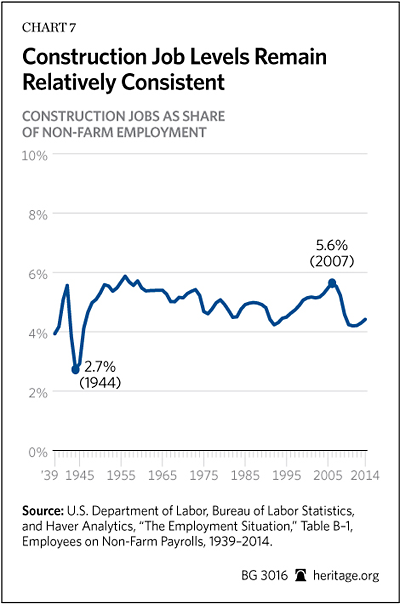
A more modern example of this phenomenon comes from restaurant tablets. Applebee’s, Chili’s, and other casual restaurants have installed tabletop tablets for customers to order and pay for their food. The new technology might reduce payrolls by allowing each server to cover more tables. However, the tablets also boost sales. Customers are more likely to order appetizers and desserts when the tablets constantly display them. The ability to pay immediately also cuts the average meal time by about five minutes. Consequently, tablet-equipped restaurants can serve more patrons during busy periods. This increases demand for employees who cook the food to order, appetizingly plate it, interact with customers, and bus the tables afterward.[23]
Whether or not these tablets will reduce the total need for human labor remains unclear. Applebee’s announced that it has not reduced total staffing since introducing the tablets.[24] Furthermore, tablets also increase tips by setting the default option to 20 percent, boosting servers’ take-home pay. Automation will change—but not eliminate—many jobs that combine routine and non-routine tasks.
Future Developments
Historical experience shows that individuals respond to technological changes by finding new jobs, typically jobs that pay more than before automation was introduced. However, technology will probably eliminate some existing occupations. Programmers will almost certainly learn how to render “routine” many tasks computers cannot currently handle. Many jobs that once appeared out of reach for automation are now being performed by machines:
- Cleaning hotel rooms has long required human labor, supplemented by technology such as vacuum cleaners and washing machines. The tasks of making a bed or removing dirty laundry from the floor were sufficiently non-routine to frustrate attempts to automate them. However, a soon-to-open Japanese hotel will use robots to perform reception duties, carry luggage, and clean rooms. The hotel will charge $60 a night.[25]
- Engineers have invented a machine that cooks 360 gourmet hamburgers an hour. The Alpha custom grills hamburger patties to order, sears the outside to maximize flavor, and cooks them in an internal oven. It then adds freshly sliced toppings and the desired condiments, places the cooked burger in a bun, and bags it. Humans only stock the ingredients and perform maintenance. The Alpha could save the typical fast food restaurant more than $100,000 per year in labor costs. The inventors are currently prototyping it at individual restaurants.[26]
- Computers have begun writing routine news articles. Many events occur with little variation in the structure needed to report on them, such as economic news releases and sports events. Computer algorithms now analyze pertinent information for readers and translate it into prose. For example, Forbes.com uses such algorithms to summarize corporate earnings announcements. Computers cannot handle more complex stories and are unlikely to develop that ability, but they can summarize regularly recurring events well.[27]
- IBM’s Watson computer is so sophisticated that it can detect correlations among research papers that human researchers have yet to discover. For example, in the field of cancer research, Watson analyzed more than 70,000 academic articles in 2014, leading to the discovery of six proteins that should be targeted for new research. One scientist noted that Watson made connections that he would have needed 38 years to make and only by reading five academic papers per day.[28] By making these types of groundbreaking causal links, Watson has demonstrated a marked technological advancement. However, it represents technology’s ability to find connections quicker than humans, not an ability to generate original research and new ideas.
Technological advancements like these will reshape the way that millions of employees do their jobs. Some jobs will disappear, but new tasks—primarily non-routine tasks—will replace jobs that have been automated. Such changes do not happen instantaneously, and most people will have time to adapt. Those who cannot adapt could be hurt, but automation will lower prices and raise living standards in the economy overall. Most Americans will prosper as a result.
Responding to Technological Innovation
Technological innovation will continue. Policymakers should respond to these challenges by promoting policies that make it easier for Americans to find new jobs.
For example, one-third of jobs in the economy require a government license.[29] In some occupations this makes sense. Few customers would want an untrained pharmacist filling their prescription. Yet in many other occupations public safety does not require stringent licensing; it primarily exists to restrict access to a profession. For example, every state licenses barbers, requiring an average of more than a year of training before prospective barbers can cut hair.[30] These requirements have no obvious safety rationale: A bad haircut threatens no one’s life. Such excessive licensing makes it difficult for employees who lose their jobs to automation to switch occupations. State legislatures should restrict mandatory licensing to occupations with serious health and safety considerations. Potential cosmetologists, florists, interior designers, bartenders, and drywall installers should not need the government’s permission to change careers. Reducing these artificial barriers would make it easier for employees to adapt in a changing economy.
State and federal policymakers can also make it easier for employees to switch jobs by eliminating unnecessary paper credentials for government positions. The K–12 education system is a large employer and continues to use paper credentials, such as master’s degrees, to structure compensation and determine access to the classroom. States should make it easier to enter the classroom by removing barriers to entry such as teacher certification requirements, but evaluate teachers more rigorously once they are in the classroom.
Education Reforms
Beyond helping individuals switch jobs, policymakers should reform the education system to help tomorrow’s employees gain the skills necessary to work in higher-paying non-routine jobs. Policymakers can do this in several ways.
States should move toward competency-based learning for both K–12 and higher education. Competency-based learning enables students to progress in their education as soon as they can demonstrate content mastery, instead of using seat time as a proxy for learning. It also enables students with professional experience or training to test out of courses and expedite their entry into the workforce.
Public policy reforms are needed to allow innovation to flourish in high schools, colleges, and career and technical fields. One of the keys to unlocking innovation is to get the federal government out of the higher education accreditation business and to hand that responsibility back to the market. The current regulatory barriers make it prohibitively expensive for most potential new education institutions to teach students. To foster a competitive marketplace of higher education content providers—be it academic or career-technical—federal policymakers should free the higher education regulatory environment so that businesses, industry, nonprofits, and colleges and universities can deliver content to prospective students from all walks of life to give them the skills needed to be successful in an ever-changing economy.
Specifically, Congress should decouple federal financing (federal student loans and grants) from accreditation and enable states to allow any entity to accredit and credential courses. Senator Mike Lee (R–UT) and Representative Ron DeSantis (R–FL) have introduced companion proposals known as the Higher Education Reform and Opportunity Act (H.R. 1287 and S. 649), which would allow states to determine who can accredit and credential courses and, importantly, would allow individual courses to be credentialed. Reforms to remove the “gatekeeper” function of accreditation could also be achieved by amending the Higher Education Act to decouple federal financing from accreditation. As Senator Lee explains:
[A]ccreditation could also be available to specialized programs, individual courses, apprenticeships, professional credentialing, and even competency-based tests. States could accredit online courses, or hybrid models with elements on- and off-campus… businesses, and trade groups could start to accredit courses and programs tailored to their evolving needs. Churches and charities could enlist qualified volunteers to offer accredited classes and training for next to nothing.[31]
The current regulatory system stifles innovation and makes it harder for individuals outside the traditional college demographic to improve their skills. Such reforms would make higher education less bureaucratic and more responsive to individual’s needs.
Conclusion
Automation reduces both labor costs and prices. Lower prices leave customers with more money to spend elsewhere, increasing the demand for labor elsewhere in the economy. Automation changes where and how people work, but it has not historically reduced the overall need for human employees.
Little empirical evidence suggests this time is different. Productivity growth slowed over the past decade after increasing in the late 1990s. The wages of the lowest-earning employees have also increased rapidly over the past generation. Instead of eliminating human labor, technological advances are reducing the need for humans in routine jobs and increasing the need in non-routine jobs. This pattern has occurred in America and around the world.
Policymakers should respond to these changes by making it easier for displaced workers to switch jobs, such as by relaxing occupational licensing requirements and moving toward policies that allow for a more nimble K–12 and higher education system to flourish.
—James Sherk is Research Fellow in Labor Economics in the Center for Data Analysis, of the Institute for Economic Freedom and Opportunity, at The Heritage Foundation. Lindsey M. Burke is the Will Skillman Fellow in Education Policy in the Institute for Family, Community, and Opportunity at The Heritage Foundation.


